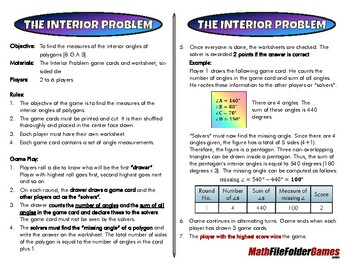The Interior Problem - 8th Grade Math Game [CCSS 8.G.A.5]
Description
Welcome to 'The Interior Problem' - an engaging and interactive math game for 8th graders that helps students master finding the measures of interior angles of polygons! This game is perfect for 2-6 players and is designed to make learning math fun and interactive. The game includes a set of game cards and a worksheet for each player.
To play, players will roll a die to determine who will be the first "drawer." The drawer will then draw a game card and share the number of angles and the sum of all angles with the other players, who will act as "solvers." The solvers must find the "missing angle" of the polygon and write the answer on their worksheet. The total number of sides of the polygon is equal to the number of angles in the card plus 1.
The game continues in alternating turns and ends when each player has drawn 3 game cards. The player with the highest score wins the game. 'The Interior Problem' is a great way to make math practice fun and interactive, and it's a perfect addition to any math class or homeschool curriculum.





